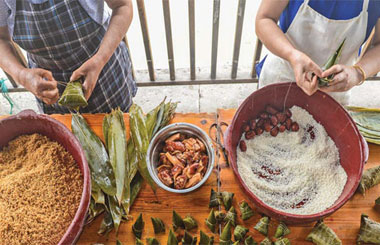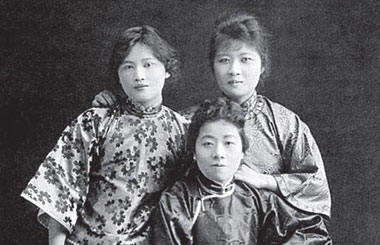Landmark for the Gyalrong Tibetans
Updated: 2016-06-09 07:48
By Li Yang(China Daily)
|
|||||||||
Serku Tibetan village is known as the first guard post of the Gyalrong Tibetans, who live along the eastern of the Qinghai-Tibet Plateau.
The village was founded in the Tang Dynasty (AD618-907) and its structures were built with nothing but rock, mud and wood.
Like Taoping Qiang village, Serku is also situated on a mountain slope above a river.
The Tibetans learned to build Qiangdiao, and construct underground water networks from the Qiang people.
The tunnel of the water network is wide enough for an adult to walk through so as to make it easy to dredge and repair. Many of the water network are still functional, 1,000 years after they were built.
The villagers use water from the mountain springs to treat common ailments, as the water is believed to have medicinal properties as it flows through land which has herbs growing on it.
Though the villagers are all Buddhists, they also worship the white-stone god, and pile quartz stones at important spots in and around their houses.
Most buildings in Serku have three floors. While the ground floor is for cattle, the middle floor is for family members and the top floor is reserved for praying.
Typically, the windows on the ground floor are small from the outside, but wide on the inside to protect the residents from strong winds.
As for grain storage, instead of creating facilities underground as is the case with many remote residences and fortifications, Serku's architects placed the wooden granaries near the village gates.
Locals say that this was done to prevent any enemy from setting fire to the village, as grains is a valuable asset in mountainous regions, particularly during long winters.
Meanwhile, despite the advent of tourism and creeping modernity, the Tibetans continue to follow their own rules when it comes to their arrangement of furnishings and daily indoor activities.
Explaining their traditions, Motsai, a woman in her 60s weaving cloth in front of her house, says: "The village has become rich with tourism. But we are committed to our beliefs. Our doctrines require us to be honest and friendly to others. That's what business success needs as well."
For Tibetans living far from each other on the mountain, the local government helps them build houses and family inns at the foot of the mountain.
Yangrong village, a three-hour drive from Serku is one such a village comprising 42 Tibetan families.
It is located in forest near a river, and produces many kinds of mushroom, fruits and cattle products.
The village now has 500 beds for travelers.
Meanwhile, there are still some Tibetans residing in their old village of Shaji on the mountain.
Many of Shaji's 314 residents are descendants of the Tusi, or the ethnic minority who were appointed by the emperors as autonomous administrative heads.
The villagers attach great importance to protecting the environment and the buildings, because they still feel a sense of responsibility as Tusi is to protect the land, says Wang Xianzhang, the village Party chief.
"They feel proud of their ancestors and are very attached to the land," says Wang.
The village also contains a Qing Dynasty Tibetan general's tomb.
The general, who died defending the land against foreign invaders, is worshipped by villagers as a model and a patron saint.
In the massive earthquake in 2008, more than 20 structures collapsed in the remote village.
But as the villagers were away praying in a temple when the quake struck, and nobody was killed in the disaster, which claimed nearly 100,000 lives.
Contact the writer at liyang@chinadaily.com.cn
(China Daily 06/09/2016 page10)
Today's Top News
China lists first sovereign offshore RMB bond on LSE
British PM denounces Brexit's 'complete untruths'
47% of European businesses would expand in China
Xi urges Washington to boost trust
Council of Europe unveils security convention
Former PM warns of chaos in case of Brexit
Basic income plan rejected by Swiss voters
Eyeing the goal in European football
Hot Topics
Lunar probe , China growth forecasts, Emission rules get tougher, China seen through 'colored lens', International board,
Editor's Picks

|

|

|

|

|

|







